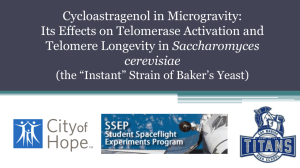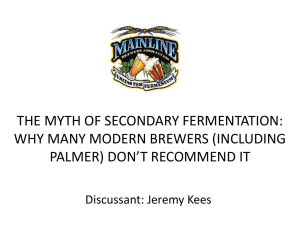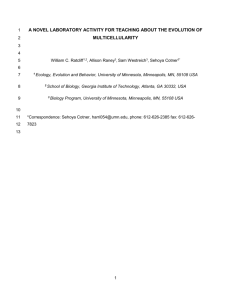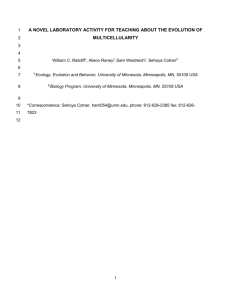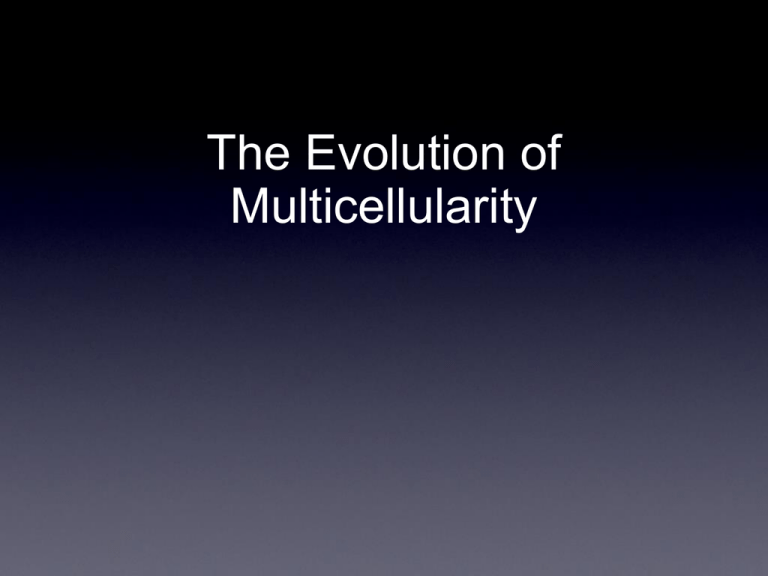
The Evolution of
Multicellularity
agenda
•
•
•
Evolution overview
Microevolution and macroevolution
Evolution of multicellularity--a laboratory
investigation
•
•
•
possible hypotheses
experimental design
data collection and analyses
Evolution & Natural Selection
•
•
•
•
evolution: descent with modification
a population-level phenomenon!
what causes populations to evolve?
how do we know evolution has occurred?
mechanisms of
change
•
•
•
•
•
mutation
migration, or gene flow
genetic drift*
natural selection*
*require genetic variation
genetic variation comes
from:
•
•
•
mutation
gene flow
sex (outcrossing, or genetic exchange)
NATURAL
SELECTION:
1. VARIATION
2. DIFFERENTIAL
REPRODUCTION
3. HEREDITY
4. ADAPTIVE CHANGE
above from: evolution.berkeley.edu/evolibrary/article/evo_01
•
•
microevolution: evolution on a small
scale--specifically, the genetic changes
that occur from one generation to the
next in a single population
macroevolution: evolution on a grand
scale--specifically, speciation or
evolutionary milestones such as the
origin of eukaryotes, multicellularity, or
vertebrates
•
but, are they really different?
“If you accept microevolution,
you get macroevolution for
free.”
-Carl Zimmer
How did multicellular beings arise from
unicellular organisms?
unicellular yeast
multicellular animal
*note: we do not mean to imply that penguins arose from bakers yeast!
•
•
requirements
Cells adhere together, forming clusters or
filaments.
Natural selection starts acting at the level of
groups, not just single cells. You need:
•
•
•
1- Variation in group-level traits that affect the
survival or reproduction of groups.
2-These group-level traits to be heritable.
The result: Multicellular adaptations, like cellular
communication and division of labor.
Ratcliff et al. (2012) in a
nutshell
•
•
Selected on single-celled baker’s yeast
(Saccharomyces cerevisiae) for fast settling through
liquid media.
in a few generations, populations exhibited an
increase in the number of “snowflake”-like clusters of
yeast
Selection for faster settling
Ratcliff et al. (2012) in a nutshell
snowflake yeast evolved to be larger and faster settling
unicellular
ancestor
snowflake yeast
after 14 transfers
snowflake yeast
after 60 transfers
Ratcliff et al. (2012) in a nutshell
•
•
Every cell in early snowflake yeast clusters was
similar.
Eventually, snowflake yeast evolved a primitive
division of labor: some cells in the cluster commit
suicide. These cells that die become “break points”,
helping the cluster to bud off new juvenile snowflake
yeast clusters.
The red cells
have died
from
programmed
cell death
When the
designated cells
die, at that
breaking point
(red areas), part
of the cluster
breaks off and
starts a new
cluster.
Time-lapse microscopy of a
snowflake yeast cluster reproducing
your task: create the conditions for
the evolution of multicellularity in lab
•
option A: modeled on Ratcliff et al.’s
(2012) experiment
•
•
•
gravitational selection for snowflake
yeast from unicellular ancestors
selection for either faster or slower
settling (divergent selection) in a
snowflake ancestor
option B: a related experiment of your
choice
the organisms
•
•
S. cerevisae, strain Y55
•
a typical, unicellular yeast, isolated
from a grape in a French vinyard
S. cerevisae, strain Y55_wk3
•
A Y55 isolate that has already
undergone three weeks of gravitational
selection
plan your experiment!
•
•
•
•
How many replicates? How many yeast
cultures?
Carefully label your tubes!
•
strain, date, transfer/day #, selection
scheme, etc.
Discuss your hypothesis and protocol prior
to beginning your experiment
Test yourself: what would data that
supports or falsifies your hypothesis look
like? Draw the graphs and explain them.
A. selection for
faster settling
B. selection for
slower settling
data-collection options
•
•
•
•
1. cells per cluster
2. cell size
3. settling speed
*measures 1 and 3 can be reported and
graphed for the entire class
Option B possibilities
•
Explore possible benefits of
multicellularity
•
•
•
•
is size adaptive? are clusters of yeast
better able to evade predation (by
Daphnia or rotifers, for example)?
are clusters more resistant to
antibiotics? UV light?
Explore conditions that would favor
unicells over multicellular organisms
The possibilities are endless!
points to ponder
•
•
•
•
advantages of multicellularity
disadvantages of multicellularity
What is the difference between a
multicellular organism, and a cluster of
cells?
is this transition reversible?
additional resources
•
•
experimental summaries, photos and
video available at micropop.org
a primer on evolution:
evolution.berkeley.edu/evolibrary/article/e
vo_01
credits
•
•
•
•
•
Will Ratcliff
Allison Raney
Samuel Westreich
Sehoya Cotner
TA’s, laboratory staff, and students
enrolled in Biology 2012 and Biology
2005 at the University of Minnesota
miscellany
This procedure
creates
gravitational
selection: taking
the cells that settle
to the bottom the
fastest.
After shaking the tube,
then letting it sit for 10
minutes, the bottom
amount is transferred to
new liquid medium.
0
7
14
21
28
35
42
60
# of transfers with selection for settling
Breakage provides
weak points where
daughters can
break off. This lets
the snowflakes
make more
offspring while
leaving the parent
large enough to
sink quickly to the
base of the tube,
ensuring its
survival




